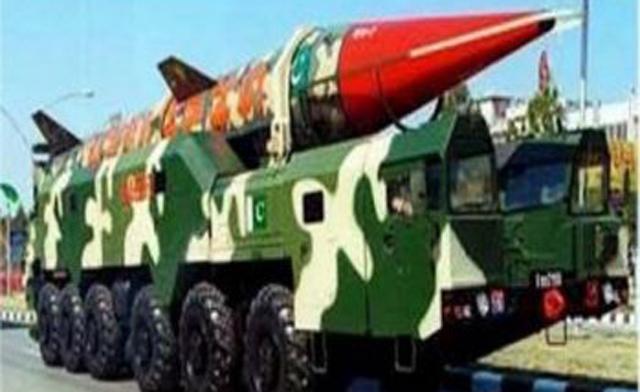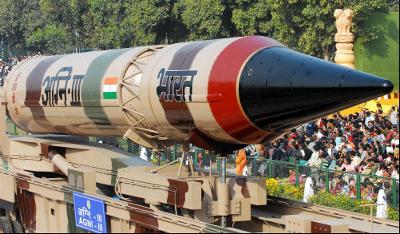www.aljazeerah.info
Opinion Editorials, February 2017
Archives
Mission & Name
Conflict Terminology
Editorials
Gaza Holocaust
Gulf War
Isdood
Islam
News
News Photos
Opinion Editorials
US Foreign Policy (Dr. El-Najjar's Articles)
www.aljazeerah.info
|
US Intelligence National Council Predicts Indo-Pakistan Nuclear War in 2028 By Abdus Sattar Ghazali Al-Jazeerah, CCUN, February 3, 2017 |
 |
 |
 |
| Pakistani nuclear missile | Indian nuclear missile |
The US National Intelligence Council has predicted a nuclear war between India and Pakistan in 2028. The prediction came in the Council report released recently under the title: Global Trends: Paradox of Progress.
Every four years since 1997, the National Intelligence Council has published an unclassified strategic assessment of how key trends and uncertainties might shape the world over the next 20 years to help senior US leaders think and plan for the longer term.
The report is timed to be especially relevant for the administration of a newly elected US President, but Global Trends increasingly has served to foster discussions about the future with people around the world, according to the Council.
About the South Asia, the report said India will be the world’s fastest growing economy during the next five years as China’s economy cools and growth elsewhere sputters, but internal tensions over inequality and religion will complicate its expansion. .….. “Pakistan will feel compelled to address India’s economic and conventional military capabilities through asymmetric means. Pakistan will seek to enhance its nuclear deterrent against India by expanding its nuclear arsenal and delivery means, including pursuing “battlefield nuclear weapons” and sea-based options.”
At-sea deployments of nuclear weapons by India, Pakistan, and perhaps China, would increasingly nuclearize the Indian Ocean during the next two decades, the report said adding: “The presence of multiple nuclear powers with uncertain doctrine for managing at sea incidents between nuclear-armed vessels increases the risk of miscalculation and inadvertent escalation. Nuclear mating requirements for naval-based delivery vehicles remove a safety valve that until now has kept nuclear weapons stored separately from missiles in South Asia.”
The report predicts three scenarios which “postulate alternative responses to near-term volatility at the national, regional and Communities levels.” The India-Pakistan nuclear clash is one of the three scenarios.
The report envisage a crisis between India and Pakistan that may result in a nuclear clash: “The Second Indus Waters Treaty was abandoned by both sides, followed shortly by a series of explosions in New Delhi that the Indian Government quickly attributed to Pakistan-based extremist groups. Islamabad denied involvement, but both sides began mobilizing their military forces. After a few confusing days of cyber attacks that disrupted the ability of both sides to understand what was happening, the situation escalated quickly. According to a subsequent investigation, artificial intelligence systems supporting the military decision makers made the crisis worse by misinterpreting signals meant to deter instead as signs of aggressive intent. The result was the first use of a nuclear weapon in a conflict since 1945.”
The report argues that “it took a mushroom cloud in a desert in South Asia (in 2028) to shake us from our complacency.”
However, Tom Engelhardt, a co-founder of the American Empire Project, does not agree with the National Intelligence Council scenario of nuclear bomb goes off not over a major city, killing hundreds of thousands, but in a desert area. He wrote:
“I, of course, don’t have thousands of experts to consult in thinking about the future, but based on scientific work already on the record, I could still create a very different South Asian scenario, which wouldn’t exactly be a formula for uniting the planet behind a better security future. Just imagine that one of the “tactical” nuclear weapons the Pakistani military is already evidently beginning to store at its forward military bases was put to use in response to an Indian military challenge. Imagine, then, that it triggered not world peace, but an ongoing nuclear exchange between the two powers, each with significant arsenals of such weaponry. The results in South Asia could be mindboggling -- up to 21 million direct deaths by one estimate. Scientists speculate, however, that the effects of such a nuclear war would not be restricted to the region, but would spark a nuclear-winter scenario globally, destroying crops across the planet and possibly leading to up to a billion deaths.”
India and Pakistan have fought three wars since they became independent in 1947. There was a standoff between the two countries in 2002 after a terrorist attack on the Indian Parliament. The standoff resulted in the massing of troops on either side of the border and along the Line of Control (LoC) in the region of Kashmir. This was the second major military standoff between India and Pakistan following the successful detonation of nuclear devices by both countries in 1998. The other had been the Kargil War in 1999.
In September 2016, India and Pakistan edged closer to all-out war over an attack on an Indian military base that killed nearly 20 soldiers. "We will destroy India if it dares to impose war on us. Pakistan army is fully prepared to answer any misadventure of India," Pakistan's Minister of Defense Khawaja Asif told a local TV network. "We have not made atomic device to display in a showcase. If such a situation arises we will use it and eliminate India."
Perhaps, South Asia or the Indian sub-continent remains among the most dangerous corners of the world. India and Pakistan share 1,800-mile border which is the only place in the world where two nuclear-armed hostile states face off every day.
The US National Intelligence Council report said it will be the combination of competing values among rival states, military build-ups, rising nationalism, and domestic insecurity that will create an era of increased geopolitical competition among the major powers.
“In the early 2020s, polarizing politics and fiscal burdens constrained US engagement on the world stage, prompting foreign assessments that the United States was moving toward a prolonged period of retrenchment. China and Russia, in particular, viewed this time as an opportunity to seek greater influence over neighboring countries within their respective regional economic, political and security orbits. Iran also attempted to take advantage of instability in the Middle East to expand its influence in the region,” the report said adding:
“By the mid-2020s, these developments led to the international system devolving toward contested regional spheres. The powers at the center of the spheres attempted to assert their right to privileged economic, political, and security influence within their regions. China increasingly used its economic and military power to influence the behavior of neighboring states and to force concessions from foreign business seeking access to its markets. India, Japan, and other states adopted more assertive independent foreign policies to counter Chinese encroachment on their interests, increasing regional tensions in East and South Asia. Russia also asserted itself more forcefully in Central Asia to keep that region under Moscow’s influence and to counter China’s growing presence.”
The US and Soviet proxy wars, especially in Vietnam and Afghanistan, were a harbinger of the post-Cold War conflicts and today’s fights in the Middle East, Africa, and South Asia in which less powerful adversaries deny victory through asymmetric strategies, ideology, and societal tensions, the US National Intelligence Council report concluded.
Abdus Sattar Ghazali is the Chief Editor of the Journal of America (www.journalofamerica.net) email: asghazali2011 (@) gmail.com
***Share the link of this article with your facebook friends
|
|
|
|
||
|
||||||


